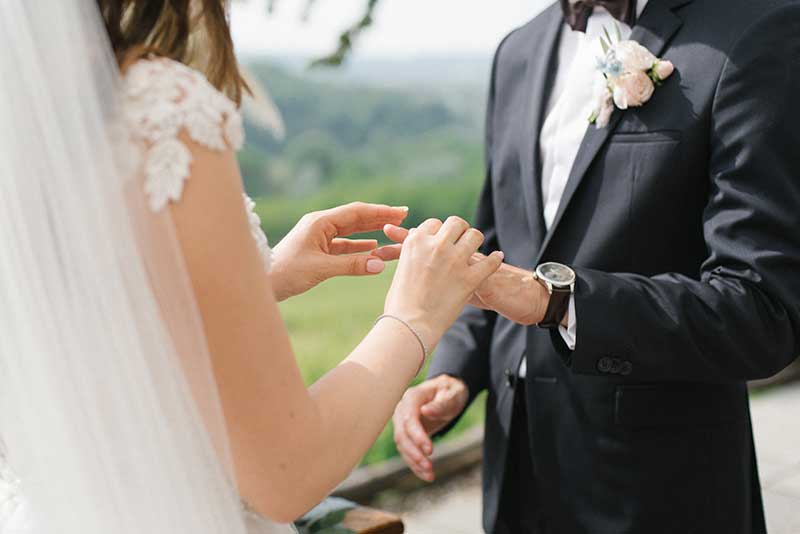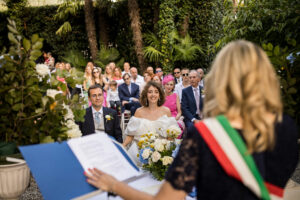In recent years, the way couples decide to celebrate their marriage has changed considerably: civil ceremonies have overtaken, if only slightly, those officiated by a religious authority in the Church, at least in Italy. In addition to the classic marriage officiated in a place of worship, or in a town hall, in the presence of a priest or a public official respectively, we increasingly hear talk of a ‘symbolic marriage‘.
But what is meant by this formula, what exactly is a symbolic marriage?
What is a symbolic marriage?
Symbolic marriage is the ceremony that unites two people in a bond of love and mutual closeness, in a totally free and personal manner, without any constraint whatsoever (be it religious or legal); symbolic marriage is a moment at a very high emotional level in which the parties involved exchange promises, often written in their own hand, and which, beyond any conventional and institutional formula, express their unique and reciprocal desires and commitments. There is nothing pre-packaged or taken for granted in such promises, just as in a symbolic wedding nothing is left to chance or custom: every detail, every word, every gesture or musical note is conceived with a precise intention: that of representing the love story and the will to join in marriage of two unique and special people who, in a special and unique way, wish to live and celebrate their union.
Why is such a union called ‘symbolic’?
Why is such a union called ‘symbolic’?
The adjective symbolic comes from the ancient Greek noun symbol, σύμβολον, sýmbolon, meaning ‘sign’. This noun derives from the verb συμβάλλω (symballo), a compound verb, formed from the preposition σύν ‘together’ and the verb βάλλω ‘to throw’; this verb thus takes on the meaning of ‘putting together’ two distinct parts.
And what are these two distinct parts that go together?
Instinctively, we immediately think of two people joining together in marriage, but it is not just that.
History and customs of the ‘symbol’
Let us not forget that in ancient Greece, the word “symbol” also had the meaning of a recognition card, a sort of ‘hospitality card’ that sanctioned an agreement, an alliance between two families or two cities or two individuals: this card, which could also be in the form of a ring, mostly made of terracotta, was broken into two parts and each of the persons or institutions involved kept one half. This half would then be reassembled, as a sign of union and mutual recognition, once the two parties had reunited after a period of distance or absence. Does this ‘symbol’, this sort of recognition card in use in ancient Greece, not immediately bring to mind the chains with the heart broken in half that, often, teenagers, best friends and/or young sweethearts, exchange as a pledge of eternal love?
The perfect matching of the two parts thus becomes the concrete and tangible symbol of the attainment of completeness, of the perfect agreement and of the union finally achieved.
And it is precisely that union, that being made for each other, that harmonious ‘matching’ in every part, that the symbolic marriage wants to represent and celebrate. No pre-packaged dogma, no transcendent entity to be honoured and worshiped, no bureaucratic or legal obligation to be fulfilled: symbolic marriage unites those who wish to manifest to their partner and to the community of reference, their will to unite.
Such a ceremony has no legal value and, as we have mentioned several times, in order to give even legal value to such a marriage, it is necessary to obtain a proxy from the authorities in charge and to entrust the ceremony to the person holding such a proxy (be it a professional figure specialized in the field or a friend of the couple who enjoys full civil rights).
What ‘symbolic marriage’ means
But those who choose a symbolic wedding are aware that beyond everything, beyond every convention and belief, beyond every social and legal obligation, it is not possible to harness feelings and relationships in watertight and rigid categories. Those who wish to celebrate a symbolic marriage know that every gesture, word, action performed during the symbolic marriage ceremony refers to something else, and encompasses multiple meanings on multiple planes of interpretation. And it is precisely in this multiple and very rich meaning that the meaning of the adjective ‘symbolic’ is best expressed: something that represents a world, a universe, a dimension known, in its complexity, only to the bride and groom, who, however, on that special day, wish to share and give a glimpse of at least a part of it also to the important and significant people in their lives.
What Symbolic Marriage actually is
In conclusion, we can affirm that symbolic marriage refers, yes, to the protagonists of the ceremony, to those who are united in marriage and who, from a duality, become a single being, composed, yes, of two different individualities, determined, however, to be together and to travel together along the path of life they have chosen; in reality, this adjective ‘symbolic’ also refers to the poignancy and multiple meaning that each gesture, word, action and sound, performed during the symbolic ceremony, ‘refers’ to something else, to that pact of love and life so rich in meaning for the couple.
A unique, precious, special and unrepeatable meaning, just as each individual and each couple that decides to unite in a loving relationship is.
If you wish, as a lay-humanist celebrant, I will be able to listen to your wishes and understand the deeper meaning of your love story, and then celebrate it in a worthy and engaging way on your most beautiful day.




